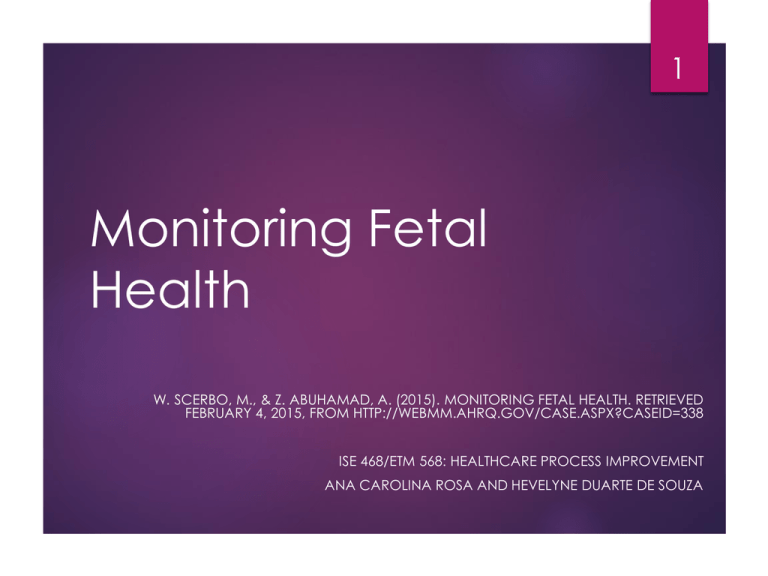Ana Carolina Rosa and Hevelyne Duarte de Souza revised
advertisement

1 Monitoring Fetal Health W. SCERBO, M., & Z. ABUHAMAD, A. (2015). MONITORING FETAL HEALTH. RETRIEVED FEBRUARY 4, 2015, FROM HTTP://WEBMM.AHRQ.GOV/CASE.ASPX?CASEID=338 ISE 468/ETM 568: HEALTHCARE PROCESS IMPROVEMENT ANA CAROLINA ROSA AND HEVELYNE DUARTE DE SOUZA 2 The Case A 29-year-old woman had an uncomplicated pregnancy with healthy fetus, and presented to the hospital with 40 weeks. But when the infant was born, he was cyanotic and flaccid with very low Apgar scores. An arterial blood gas at the time showed a pH of 6.70 (normal: 7.25–7.35), a profound acidosis. The infant required extensive resuscitation but survived and was transferred to the neonatal intensive care unit. The infant had brain injury from inadequate oxygenation of the brain that occurred during childbirth and other problems related to the complicated delivery. “The fetus had been monitored using the standard fetal heart rate tracings throughout the time of labor. The fetal heart rate tracings had shown evidence of Category 2 and 3 abnormalities (moderate-to-severe fetal distress) for at least 90 minutes prior to the delivery. These abnormalities, which likely would have prompted an urgent cesarean delivery, had not been recognized by any of the physicians or nursing staff.”(p.1) In this institution, continuous fetal heart monitoring of all of the women in labor was displayed centrally on a large 40-inch monitor; on this screen 16 rooms were displayed continuously on it and with two nurses watching it. ISE 468/ETM 568: Healthcare Process Improvement Ana Carolina Rosa and Hevelyne Duarte de Souza 3 The Comentary This case involves failure to recognize concerning fetal heart rate (FHR) tracings during labor; “FHR activity and maternal contractions are recorded by transducers placed on the maternal abdomen and tracings can be displayed either on a paper strip or a computer screen” (p.2); The baseline heart rate is measured in beats per minute (bpm) and measured over a 10-minute period; Normal mean values for FHR : range from 110 to 160 bpm; Deviations in the baseline activity are classified as: Absent (no noticeable bpm variation); Minimal (up to 5 bpm); Moderate (variability ranges from 6 to 25 bpm); Marked (exceeding 25 bpm). ISE 468/ETM 568: Healthcare Process Improvement Ana Carolina Rosa and Hevelyne Duarte de Souza 4 Categories of FHR The National Institute of Child Health and Human Development (NICHD) recently presented a new classification of FHR monitoring Intent is to standardize communication among health care providers and stratify fetal risk; Risk is classified as: Category 1: normal fetus Category 2: intermediate risk requiring close observation and monitoring Category 3: possible fetal compromise ISE 468/ETM 568: Healthcare Process Improvement Ana Carolina Rosa and Hevelyne Duarte de Souza Technological advancements on monitoring FHR Analog devices were located at the patient's bedside. Signals were traced with a pen onto a printed grid on paper that scrolled at a standard rate 5 Digitalized signals are presented on a computer screen and can be monitored from a remote location usually placed in the nursing suite of the labor and delivery unit— because it allows many patients to be monitored simultaneously in a single location (centralized) ISE 468/ETM 568: Healthcare Process Improvement Ana Carolina Rosa and Hevelyne Duarte de Souza 6 Differences The digitization of FHR signals allows one or more tracings to be displayed on a standard computer screen In this case, data from 16 patients were displayed on a single 40-inch monitor, each tracing would be limited to about a 10-minute window of activity (assuming a 4 x 4 matrix); on the other hand, traditional paper tracings enables a clinician to scan 30 minutes or more of activity. ISE 468/ETM 568: Healthcare Process Improvement Ana Carolina Rosa and Hevelyne Duarte de Souza 7 Differences Related to the attentional challenges to monitor the displays. Vigilance decrement: the ability to maintain attention and respond to stimuli over long periods of time. Monitoring multiple displays or multiple sources of information depicted within a single display also tends to harm performance. In one study, observers asked to monitor multiple displays detected fewer signals and had more false alarms than those observing only a single display, because of that equipment designers should try to avoid creating displays with multiple components that need to be monitored. ISE 468/ETM 568: Healthcare Process Improvement Ana Carolina Rosa and Hevelyne Duarte de Souza Safety Culture on Labor and Delivery Units This complicated patient flow requires dedicated specialized teams with strong commitment to safety. Triage 8 Labor room Delivery/Operating room Recovery room “Having a centralized monitoring station with insufficient number of available, well trained, vigilant, and undistracted personnel to monitor can be a recipe for bad outcomes.”(p.4) ISE 468/ETM 568: Healthcare Process Improvement Ana Carolina Rosa and Hevelyne Duarte de Souza Simple solutions to improve the detectability of critical signals and minimize vigilance decrements Additional training; Having more than one person monitoring the displays; Limiting the duration of watchkeeping shifts. More sophisticated possibilities: 9 amplifying the signals using systems that provide warnings generated by computerized analysis of the FHR tracings ISE 468/ETM 568: Healthcare Process Improvement Ana Carolina Rosa and Hevelyne Duarte de Souza 10 Conclusion “Fetal heart rate monitoring on labor and delivery is a complex process that is often affected by staff education and training, staffing levels, and the unit safety culture. Centralized monitoring introduces significant changes in the way patients are monitored. These changes are accompanied by some obvious advantages and some less obvious disadvantages. Attempts to combat monitoring deficits in other high-risk domains with more sophisticated technology have reduced but not eliminated failures of attention. Improving communication on the labor and delivery unit and establishing an ultra safe and resilient culture that promotes transparency are two major components of accurate interpretation of FHR.” (p.5) ISE 468/ETM 568: Healthcare Process Improvement Ana Carolina Rosa and Hevelyne Duarte de Souza 11 Reference http://webmm.ahrq.gov/case.aspx?caseID=338 ISE 468/ETM 568: Healthcare Process Improvement Ana Carolina Rosa and Hevelyne Duarte de Souza





